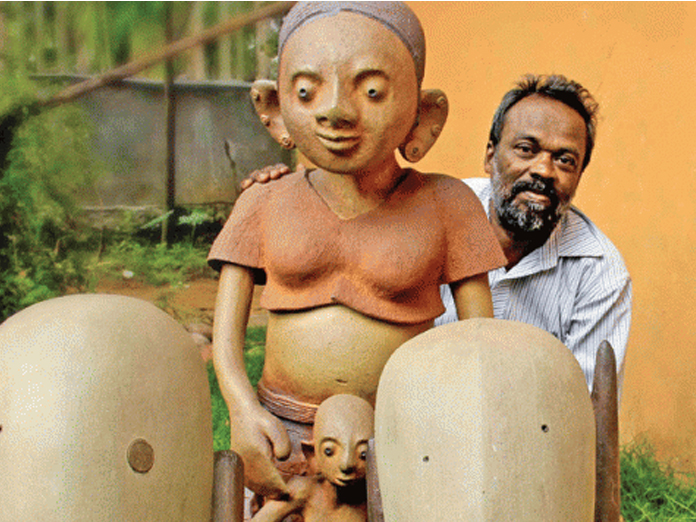Live
- Rajasthan bypolls: A tough contest between BJP and Congress
- Albania joins SEPA, paving way for EU integration
- Japanese government approves 250-billion USD economic package to ease price pain
- Six pharma companies to set up their units in Telangana
- The Unstable Events of a 17-Wicket Day in Perth: India vs Australia
- Dutch FM's Israel trip cancelled after Netanyahu's arrest warrant
- UK to increase energy price cap by 1.2 per cent
- Ethiopia launches national coffee platform to maximise earnings
- Centre completes auction of 3 coal blocks, to yield annual revenue of Rs 2,710 crore
- Ullal Woman Files Complaint Against Husband Over Instant Talaq and Abuse
Just In

After 15 years, sculptor G Reghu has come to Mumbai where most of collectors live One of his most cherished collectors, Sangita Jindal, opened his show at the Jehangir Art Gallery on Tuesday
Mumbai, Jan 15: After 15 years, sculptor G. Reghu has come to Mumbai where most of collectors live. One of his most cherished collectors, Sangita Jindal, opened his show at the Jehangir Art Gallery on Tuesday.
Reghu's language and aesthetic has been moulded by two significant encounters: His early contract with Elizabeth and Laurie Baker with their Gandhian philosophy of working with indigenous materials and J. Swaminathan at the Bharat Bhavan who, in his persona of a "tribal" artist, voiced the cause of the dispossessed, says Uma Nair, one of India's foremost curators who has studied Reghu's works for over two decades.
The surface of Reghu's work in its muted organic earth colours, has a matte finish. The work is shaped by an artist who is intimate with the tactile processes of using his hands: Patting mud walls, throwing the clay on the potter's wheel or even dexterously kneading dough and handling food. The medium and method reflect familiarity with a rural lifestyle.
"Using the processes of hollow-modelling, slabbing, folding, coiling and pinching, Reghu creates a racial type that mingles Dravidian and African facial features -- bulging eyes, thick lips, cabbage ears -- evocative of an ancient civilization and its wisdom. His "head" exudes both a warmth and an innocence which are typical of his work.
"These are almost doll-like, tribal images are evocative and full of conversations. The motif of the Indian villager dominates and he is placed in situation open to excitement and anxiety. Nostalgia for lost childhood is replete in his figurative compositions of a boy watched by two garden lizards. The cows also moo and talk," said Nair, who has curated the show, which will run till January 21.
Reghu, like some of his contemporaries, has moved from the earlier formalistic style in sculpting to the deliberate use of the figure and its dynamics as a subject of exploration.
The choice of terracotta -- a fragile material with a timeless quality -- is consonant with the sculptors' desire to revive the folk-craft tradition. The sensuous texture of terracotta and its innate plasticity lends itself to be skillfully exploited.
His new works display a playful grouping of women and children at leisure and in expressions of joyous celebration and wonder. Some of the figures are assemblages of fragmented body parts which can be inter linked to form the sculpture in its entirety.
Reghu transverses in his quest from well-defined regional images to a realm which includes the magical inter-play of myth and reality.
"He casts himself in the role of a village craftsman to reclaim lost territories of innocence and utopia," Nair explained.

© 2024 Hyderabad Media House Limited/The Hans India. All rights reserved. Powered by hocalwire.com







